Building 'Isle of Man Steam Packet'
- words by Mike Casey
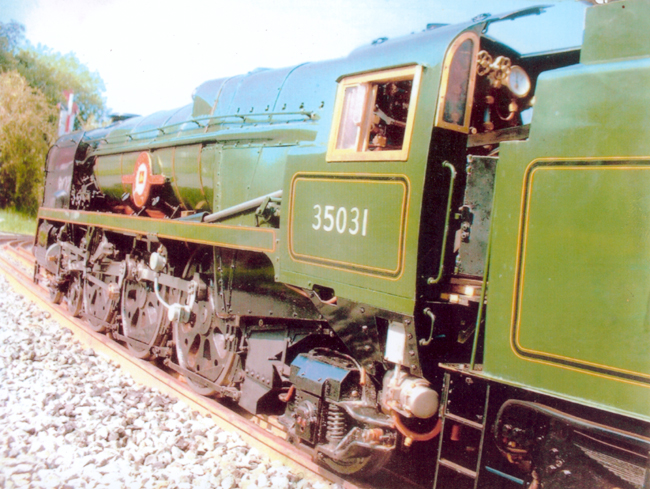
Opinions vary as to the merits of the original and rebuilt versions, however my choice was for the rebuilt locomotive.
First of all I liked the look of it, and secondly the idea of a chain driven valve gear was not really my cup of tea.
However, others have built the chain driven version successfully.
Both original and rebuild share a considerable number of parts, and it was claimed that after the rebuild it was still 90% Mr Bulleid's engine.
Calling the locomotive "Ariel", starting in late 1984, Keith Wilson wrote a series in the M.E. for the rebuild; drawings and castings are available from M.J. Engineering.
It is to be frank not an easy locomotive to build, and not one for a first timer, but it is extremely interesting, and the methods described below maybe of help.
The building of the locomotive was completed over a 5 year period, although other jobs did stop progress at times.
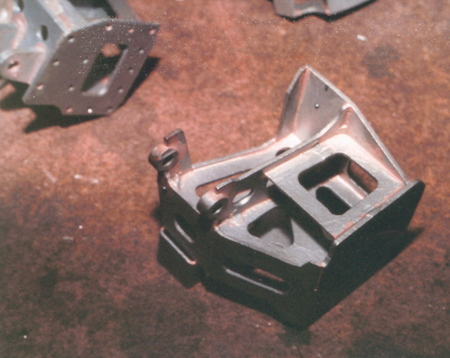
Frames and Stretchers.
Nothing unusual about the frames except that the hornblocks go on the outside.
There are though a number of frame stretchers, motion brackets and guide bar brackets that are quite complex.
The inside motion bracket is a case in point, and the photo shows this along with an outside bracket on the left of the picture.
The brake gear was also attached to some of these fabrications.
Steel is used for all of these items and a most useful source of supply is a fabrication workshop.
These days many use Zintec, which is coated but ductile, and will silver solder well.
I have never detected any fumes from it, but like any silver soldering operation work in a well ventilated space.
Usually a couple of pounds in the tea money box will produce enough offcuts from their skip to keep one going for ages. (I always as a matter of habit inspect all engineering Company's skips.)
For marking out, a sharp pencil shows up better than a scriber.
The problem with constructing fabrications of this type is keeping the various bits in the right place while they are heated.
Screws tapped into the plates can be used, but this gets a bit difficult when using 16 or sometimes 18 gauge plates.
Bits of angle, unless they can be hidden, look dreadful.
However, a MIG welder offers a very useful solution.
I do not attempt to MIG weld the whole fabrication, but merely use it to produce a series of 'spots', just enough to hold things together on the brazing hearth.
Then silver solder, pickle for about ten minites and wash off.
A bead blasting cabinet saves no end of time when trying to clean up a fabrication with hard to get at areas.
I try to arrange the MIG spots where they can be easily filed off later.
I do not attempt to do everything in one go on a complex fabrication, but find it better to silver solder 4 or 5 bits, clean up, and then move on further.
Everything is cut up with a "cheapo" Far Eastern bandsaw in the vertical position.
There is a great deal of sheet work in a steam loco, more than newcomers realise, but the technique described can also be used for items like cabs and running boards, and it costs next to nothing.
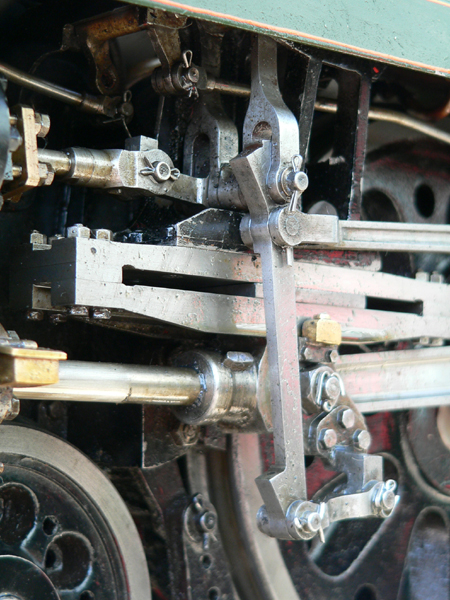
Cylinders and Running Gear.
The piston valve cylinder castings supplied were a masterpiece of the pattern maker and foundryman's art, with cast in passages on the inside cylinder that take care of the exhaust from the outside cylinders.
I fitted Klipet rings to the pistons, and originally intended to fit rings to the piston valves.
However with the liners being separate I was concerned that a ring could break when the valve was being assembled on it's travel through the central area.
I did consider two piece valves, but in the end went for strightforward cast iron bobbins, with oil grooves working in the cast iron liners.
After quite a bit of running they are still steam tight.
The driving wheels are fitted with steel tyres; I believe that a steel tyre on a steel rail grips better, and also wears better.
They are shrunk on using the old rule of a 'thou' for every inch of diameter plus a 'thou'.
So a six inch wheel has a shrink of 7 thou.
For those who have now gone all metric, I will leave you to do the maths.
I use a gas ring to heat the tyres, and go to dark brown and just starting to turn blue.
Then turn off the gas and drop the whhel centre in.
If it shows the slightest sign of sticking, stop, let things cool off and check your measurements.
If it does stick halfway you will end up turning the tyre off and starting again.
However, if all is as it should be, the wheel centre will drop in quite easily landing on the rim, which is on the front face of the tyre.
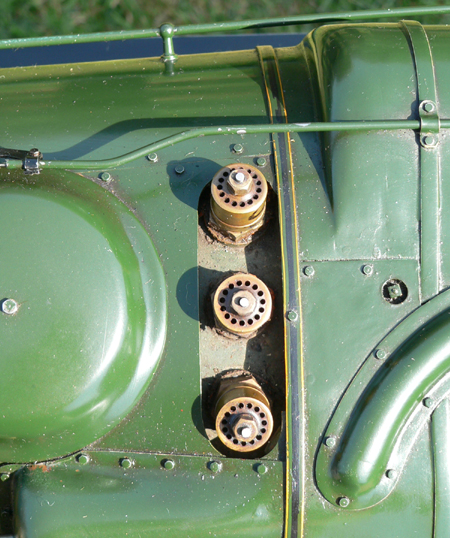
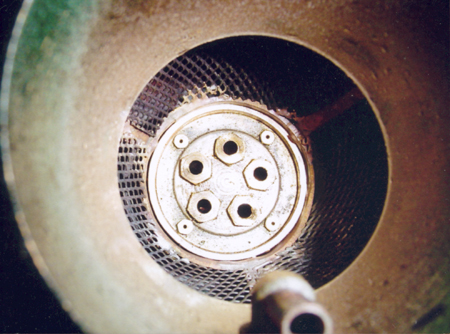
Boiler and Smokebox.
Mr Bulleid did a great job here; these were super steam raisers, and so are the small versions.
Like most boiler work, construction is fine if you have got the heat and the manpower.
By the latter I mean two people on the brazing.
I rely solely on propane and do not have Oxy acetylene, or to be honest, enough experience using it.
The only complication here is the combustion chamber, but as there are no water tubes, it is all "get at able" using a cyclone burner should there be any problems.
I believe in blocking tubes during silver soldering operations once the boiler is in it's final stages.
Reason being that otherwise they heat very easily, expand, and then during the process of cooling contract again, "pulling" the semi-molten joint and causing a crack.
None of this matters in the early stages as the other ends of the tubes are free to move.
Plugging the tubes with asbestos not being an option these days, I wondered at first how well "Kaowool" would work.
Well it does and very well.
A friend gave me a bin bag of the stuff and it is a superb aid during solver soldering.
I now insulate everything I can, and heating up is a lot quicker and more economical.
After much thought, the grate was made in one piece and slides completely out of the left-hand side (or should it be port ?), following removal of the small outside ashpan.
This saved using a dropping middle section and makes possible repairs or renewal of the grate without lifting the boiler.
The multiple jet exhaust provides a very soft blast, but will lift coal off the shovel when working hard.
Keith Wilson's design had called for five 1/4 inch holes.
In total these seemed a bit large, and I fitted removable nozzles of 3/16 inch instead, partly to allow for the spark arrestor.
However Keith is right on this one, I am sure the larger nozzles would be OK, although I've not got around to altering mine.
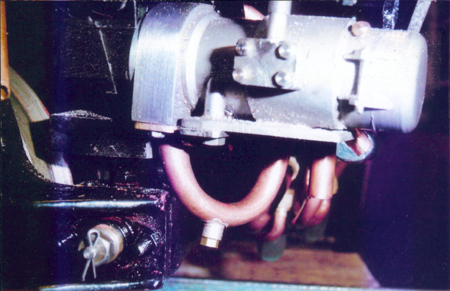
Turbo Generator.
This seemed worth a go and in the M.E. of 17th January 1987 one had been described by Tery Timms.
He used a small Elipse button magnet, which exited on end three coils thus producing a three phase supply.
I did not find the steam end difficult but it took three attempts to wind the coils.
It was connected to three bulbs being spares for Maglite torches.
White LEDs might well be better.
It worked quite well but the first set of bearings seized up after a few weeks, and the second set even quicker !
So it is back to the drawing board on this one.
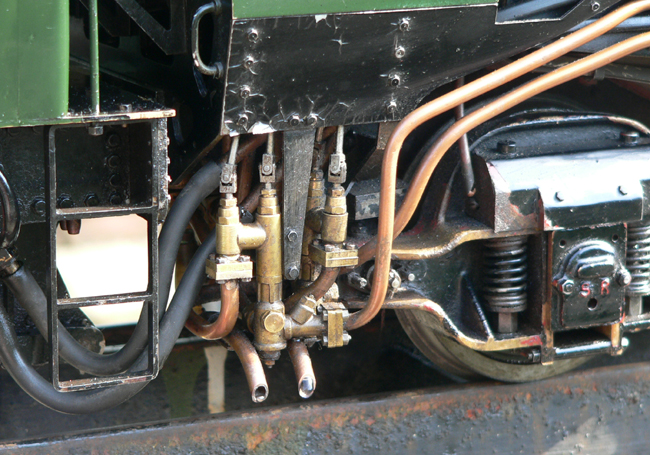
Injectors.
During May 1976 Bazil Palmer of South Africa wrote two very good articles on Injectors in the Model Engineer.
He gave dimensions for a variety of feed and pressure rates.
My loco is fitted with two of the largest size he describes using a No 69 delivery cone.
I've now made nearly 40 of these injectors for friends and myself.
Provided Bazil's instuctions are followed with care, a successful injector will result.
They will pick up with steam or water on first go and suck if need be, a couple of feet.
One thing they will not tolerate though is air in the water suction.
An ordinary cock in the suction line is doubtful to say the least, and proper glands are needed on the cock body.
However so long as this is provided along with an adequate steam supply, they do not seem to mind how torturous the delivery side is, despite what one reads elsewhere about making smooth bends etc.
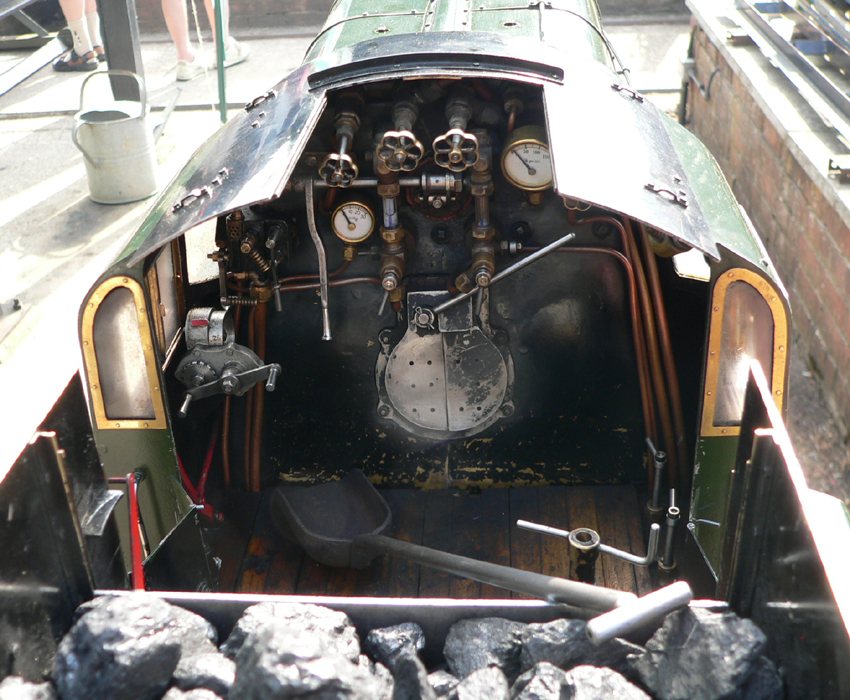
Driving.
The curves on my own track are too tight for the M.N. and the only available local track is ground level.
At ground level I find the long tender with which a M.N. is fitted hard to stretch over.
Many people settle for sitting on the tender, and I strengthened the tank with this in mind.
However in the end I fitted a cantilevered seat to a long driving truck which lifts the backside over the rear of the tender.
The footboards are extended forward, and everything is now in comfortable reach.
The driving truck is ballasted with an old car battery to stop it tipping forward.
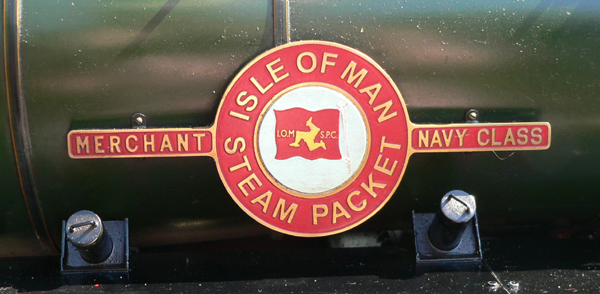
Name and Number.
There was never an 'Isle of Man Steam Packet Co Ltd' or 35031 in full size, but I always thought there should have been.
With the island being my home, I fully admit to prejudice, but after loosing three ships at Dunkirk and evacuating over 24,000 troops the Company was surely deserving of the honour.
Anyway at least it made it in 5 inch gauge, and I suppose there is less chance of it being scrapped.